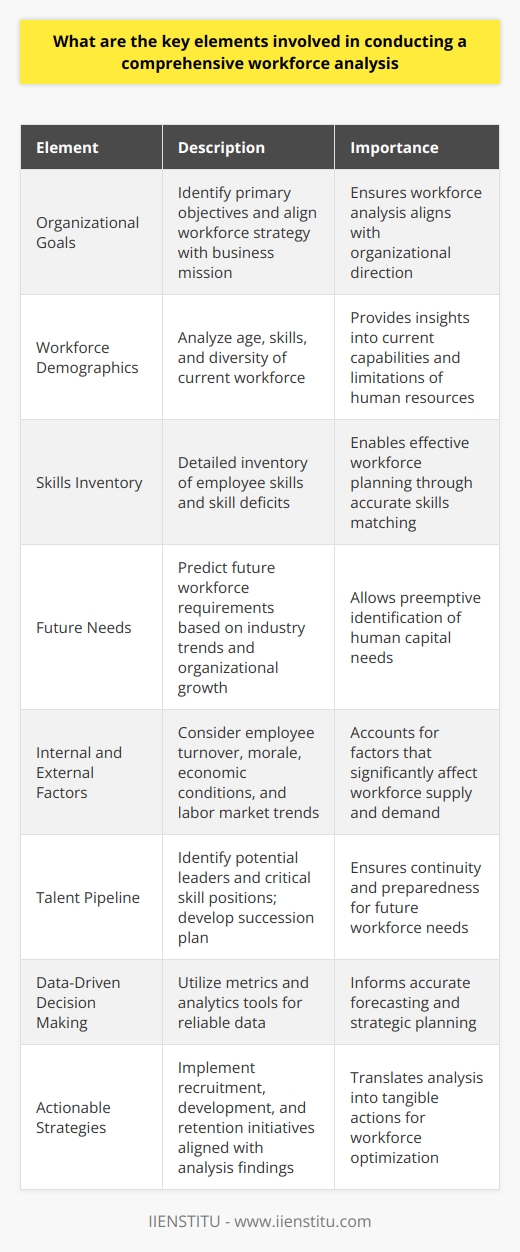
In an era marked by rapid technological change and global competition, organizations are continuously seeking strategic advantages that lead to business success. One critical area often overlooked is workforce analysis, a process that aligns an organization’s staff with its strategic goals.
This article serves as a practical expedient for managers and HR professionals aiming to harness the analytical insights of their organization's most critical asset - their human capital.
By combining comprehensive knowledge and a user-oriented approach, this guide seeks to delve into the significance of workforce analysis as a tool for achieving optimal organizational performance.
Introduction to Workforce Analysis
Workforce analysis encompasses the methods by which an organization gathers and examines data related to its employees to make informed business decisions.
This essential aspect of human resource management imparts clear insights into the current and future needs of the workforce, aiding in proper staffing and resource allocation. It empowers organizations to preemptively recognize and remedy skills shortages, surpluses, and other workforce dilemmas that might otherwise jeopardize their short and long-term objectives.
Strategic workforce planning involves aligning the existing workforce with the anticipated needs of the organization. This forward-looking approach incorporates various methodologies to pilot the business towards meeting its goals efficiently and effectively.
By incorporating factors such as market trends, emerging skill sets, and business expansion plans, strategic workforce planning serves as a blueprint for growth.
The key elements in the workforce analysis process include assessing the current workforce, predicting future workforce needs, and identifying the gap between the present and future. It scrutinizes roles, skills, experiences, and performances within the company.
A well-executed workforce analysis ensures the right talent is in place at the right time, reducing the risk of talent shortages and surpluses that can impede progress.
The Role of Workforce Analysis in Business Strategy
Effective workforce analysis is undeniably correlated with efficient business strategy. When organizations understand their current workforce capabilities and how they match up with future business strategies, they can make data-driven decisions that align human capital with business objectives. This not only maximizes the contribution of each employee but also enhances the organization's agility in the face of changing market demands.
Aligning workforce analysis with business objectives ensures that the human capital strategy dovetails seamlessly with the organization's vision and strategic goals.
For example, if an organization plans to venture into new markets, workforce analysis will help identify the necessary staff competencies, thus enabling targeted recruitment and training. As organizations pivot and grow, such alignment ensures that their workforce remains a driving force for success and innovation.
An illustrative case of organizational issues due to a lack of strategic workforce planning can be seen in a company that failed to predict the impact of digital transformation on its business model.
Without a proper workforce analysis, this organization was unable to adapt to new technological requirements, leading to a competitive disadvantage. The company faced significant skill gaps, leading to project delays and customer dissatisfaction.
How Workforce Analysis Helps in Talent Management

A better understanding of the workforce allows for more effective talent management, a core area where workforce analysis plays a pivotal role.
By providing clear insights into the competencies and potential of current employees, workforce analysis enables a company to make informed decisions on talent identification, recruitment, progression, and retention strategies that contribute to the company's overall objectives.
The impact of workforce analysis on talent identification, attraction, development, and retention is profound. Through detailed data examination, organizations can unveil patterns that help in recognizing high potentials and skill gaps within the existing workforce.
This ensures that talent development initiatives are well-aligned with organizational needs while also addressing employee aspirations, leading to a more engaged and committed workforce.
Workforce analytics are critical to building a future-ready talent pool, preparing the organization to address challenges and seize opportunities across the evolving business landscape. Comprehensive analytics can predict future skill needs, guide succession planning, and enable proactivity in HR practices.
As organizations chart their course through an ever-changing business environment, workforce analytics stand as a critical tool in the arsenal of strategic human resource management.
Key Components of Workforce Analysis
A pivotal component of workforce analysis is supply analysis, which scrutinizes the current composition and distribution of the organization's workforce. It evaluates the availability, competencies, and performances of current employees.
Understanding the workforce supply is instrumental for identifying existing capabilities and areas where staff development or talent acquisition might be required.
When it comes to demand analysis, it holds substantial relevance in the planning of human resources as it forecasts the type, quantity, and quality of employees an organization will need to meet its future strategic goals. Considering factors like emerging market trends, projected retirements, and evolving company objectives, demand analysis plays a vital role in anticipating future workforce requirements.
The gap analysis component identifies the discrepancies between the present workforce supply and the future workforce demand. This analysis assists organizations in developing strategies to bridge gaps through initiatives such as training programs, hiring drives, or organizational restructuring.
Being able to anticipate and plan for such gaps is crucial in maintaining smooth operations and achieving long-term success.
The Role of Technology in Workforce Analysis
In today's digital age, data-driven insights are indispensable to workforce analysis and planning. Technology enables the collection, processing, and interpretation of vast arrays of employee data faster and more accurately than ever before. The deployment of advanced analytical tools can uncover valuable trends that support strategic decision-making and operational improvements.
There is an array of data analytic tools that ease workforce analysis by offering functionalities ranging from predictive modeling to natural language processing. These tools can swiftly analyze data sets, provide visual representations, and offer actionable insights.
Their utility extends to various HR functions including workforce planning, compensation analysis, and employee engagement strategies.
A notable case study is the digital transformation of workforce analysis in a leading corporation that harnessed big data and artificial intelligence to underpin its HR decisions.
The company implemented an advanced workforce planning platform that aggregated data across various systems, providing real-time analytics that enhanced decision-making and resulted in significant improvements in their talent management efficiency and operational performance.
Future Perspectives: Workforce Analysis Post-Covid
The global pandemic has dramatically influenced workforce trends, necessitating a reassessment of workforce analysis methodologies.
The sudden shift to remote work, increased emphasis on employee well-being, and rapid technological adoption have introduced new factors into workforce planning and analysis. As a result, organizations must adapt their workforce strategies to accommodate these altered circumstances.
Emerging workforce trends, including the growth of gig work, remote teams, and the need for resilience and adaptability, are demanding a shift in workforce analysis methodologies.
In the post-Covid era, companies are required to navigate new complexities in workforce planning, focusing on flexibility, skills analysis, and the integration of technology to ensure business continuity and growth.
Proactive and advanced workforce strategies have become more critical than ever. Organizations must deploy continuous, dynamic workforce analysis tools and techniques to stay ahead of the curve, ensuring that they have the right talent in place to meet current needs and adapt to future challenges. Embracing this strategic mindset will be key to thriving in the post-pandemic marketplace.
Recap of Workforce Analysis as a Strategic Tool
The integration of continuous workforce analysis into business strategy is more than a necessity; it is a transformative measure for organizations aiming to remain competitive and agile.
It enables businesses to make intelligent, evidence-based decisions regarding their talent management, ensuring alignment with their overall strategic objectives.
A well-planned and executed workforce analysis can be a game-changer for organizations, offering insights that range from immediate staffing needs to long-term succession planning.
Its role as a strategic tool cannot be overstated, with the potential to significantly influence and enhance all aspects of organizational performance.
In reflecting upon the potential of workforce analysis, it brings to the fore its impact on creating a highly efficient and productive business environment.
When harnessed correctly, workforce analysis can spell success not just for the HR department, but for the entire organization, fostering an empowered, forward-thinking, and performance-driven culture that is ready to face the challenges and opportunities of the future.
Frequently Asked Questions
What are the key elements involved in conducting a comprehensive workforce analysis
Understanding Workforce Analysis
Workforce analysis stands as a crucial step for any organization aiming to comprehend the dynamics of its human capital efficiently. It involves various key elements that must interplay harmoniously to ensure success.
Identify Organizational Goals
Initially, workforce analysis requires clarity in organizational goals. Identify the primary objectives. This understanding aligns the workforce strategy with the overarching business mission.
Analyze Workforce Demographics
Understanding the current workforce is vital. Analyze age, skills, and diversity. Such demographics give insights into the current capabilities and limitations of the human resources within the organization.
Assess Skills Inventory
Having a detailed skills inventory is imperative. This inventory addresses two key questions. What skills do employees possess? What skills are in deficit? Accurate skills matching fosters effective workforce planning.
Determine Future Needs
Predict future workforce requirements. Anticipate industry trends and organizational growth. Align this foresight with strategic business plans to preemptively identify human capital needs.
Consider Internal and External Factors
Workforce analysis is not stagnant. Consider both internal and external factors. Internal factors include employee turnover and morale. External factors encompass economic conditions and labor market trends. Both can significantly affect workforce supply and demand.
Evaluate Talent Pipeline
A talent pipeline review is essential. Identify potential leaders and critical skill positions. Develop a succession plan to ensure continuity.
Data-Driven Decision Making
Reliable data is the cornerstone of workforce analysis. Utilize metrics and analytics tools. This data-driven approach informs more accurate forecasting and strategic planning.
Create Actionable Strategies
Finally, translate analysis into actionable strategies. Implement recruitment, development, and retention initiatives aligned with analysis findings. These strategies must be agile to adapt to any unforeseen changes in workforce dynamics.
By intertwining these elements, organizations can conduct a comprehensive workforce analysis. It sets the bedrock for strategic human resource planning, fostering organizational resilience and adaptability in an ever-changing business landscape.

In what ways does workforce analysis contribute to optimal organisation performance
Understanding Workforce Analysis
Workforce analysis serves as a detailed study. It evaluates an organization's workforce. It identifies skills and competencies. It assesses how these align with goals. Optimal organization performance hinges on various factors. Among these factors, workforce analysis stands out. It contributes to improving performance significantly.
Aligning Skills with Organizational Goals
Workforce analysis explores current employee skills. It matches them to future needs. Organizations need the right skills for strategic goals. Without alignment, performance can falter. Skills gaps become apparent through analysis. This allows for targeted training. It also helps in effective recruitment.
Forecasting Future Workforce Needs
Organizations must anticipate changes. Workforce analysis allows for this forecasting. It predicts future workforce requirements. These requirements may be due to growth or technology changes. Knowing these needs helps with planning. It ensures organizations remain competitive and agile.
Improving Resource Allocation
Resource allocation is critical. Workforce analysis provides insights into human resource utilization. Are we using employees effectively? This question becomes easier to answer. With analysis, we can adjust resource allocation. Thus, we enhance productivity and reduce waste.
Enhancing Employee Engagement
Employee engagement correlates with performance. Workforce analysis identifies engagement levels. It also reveals what influences these levels. Organizations can design strategies to boost engagement. Engaged employees often perform better. They also contribute to better organizational outcomes.
Succession Planning
Future leaders are essential to performance. Workforce analysis facilitates succession planning. It helps identify potential leaders within the workforce. These individuals can fill critical roles in the future. Without planning, leadership gaps can emerge. Such gaps can cripple an organization's performance.
Reducing Turnover
High turnover is a performance killer. Workforce analysis helps to understand turnover causes. By addressing these causes, organizations can retain talent. Retaining talent contributes to stability and performance consistency.
Data-Driven Decision-Making
Decisions require data. Workforce analysis provides that data. It allows for evidence-based decision-making. Such decision-making is crucial for optimal performance. It ensures choices reflect reality. It also minimizes the risk of costly errors.
Mitigating Risks
Risk mitigation cannot be overlooked. Workforce analysis identifies potential risks. These might include compliance issues or skill shortages. Knowing risks allows for proactive measures. It strengthens the organization against future uncertainties.
Conclusion
Workforce analysis is indispensable. It offers deep insights that drive better performance. Organizations leverage these insights for strategic advantage. They result in wiser investments in the workforce. Stronger performance usually follows suit. Overall, workforce analysis is a cornerstone of organizational excellence.

How does understanding the demographics and skillset structure of a workforce help in strategic planning and decision-making?
Understanding Workforce Demographics and Skillset Structure
Strategic planning and decision-making become more nuanced with an understanding of workforce demographics. Leaders must comprehend the myriad traits that comprise their personnel's makeup. Age, gender, education, cultural background, and experience shape a workforce's collective capability.
Age Distribution Influences Strategy
A workforce's age profile suggests distinct needs and predilections. Young workers often bring innovative outlooks and agility, while older employees offer deep-rooted experience and wisdom. Strategists must align workforce planning with age-related trends. Continuous learning and skill upgrades become crucial for older demographics. Youth may require more mentoring and professional development opportunities.
Gender and Cultural Diversity Enhance Creativity
Diverse groups outperform homogeneity in innovation and creativity. Varied perspectives drive enhanced problem-solving. Strategists leveraging diversity build stronger, more adaptive teams. Decision-makers must ensure inclusive cultures to harvest this potential.
Skillset Analysis Drives Organizational Capability
Skillset breakdowns illuminate critical competencies and gaps. Understanding existing expertise enables leaders to capitalize on strengths effectively. It provides a clear path to address skill shortages through hiring, training, or partnerships. An accurate skillset map informs resource allocation and shapes future learning agendas.
Aligning Workforce Insights with Strategic Goals
Aligning workforce analytics with strategic objectives streamlines goal attainment. Knowledge of employee demographics and skillsets allows for setting realistic targets. It ensures the alignment of human resources with the broader organizational mission.
Identifying Skill Gaps for Proactive Planning
Recognizing skill gaps early leads to proactive measures. Training programs or recruitment drives can preempt labor market shortages. Tailored strategies mitigate risks associated with skill scarcity. A nuanced approach to workforce planning future-proofs an organization.
Enhancing Employee Engagement and Retention
Employee engagement thrives under mindful leadership. Understanding workforce composition can lead to more personalized engagement strategies. Career progression pathways and recognition programs may vary significantly across different demographic groups. Insights inform retention strategies crucial for maintaining institutional knowledge and minimizing turnover.
Adapting to Evolving Labor Market Trends
Labor markets evolve rapidly, influenced by technology and global events. An acute understanding of workforce characteristics equips leaders to navigate these changes. They can adjust strategies to incorporate remote work models, flexible hours, or digital skill enhancement accordingly.
Succession Planning
Effective succession planning hinges on demographic and skillset insights. Recognizing potential leadership within existing ranks ensures continuity. Development programs can target high-potential individuals. This strategic foresight reduces disruption during transitions.
Conclusion: Data-Driven Decisions Foster Sustainable Growth
In sum, demographic and skillset analysis supports targeted, informed decisions. These insights guide workforce development, the allocation of resources, and strategic pivots. The aggregate leads to sustainable organizational growth and a competitive edge in the marketplace. Data-driven strategies underpin the evolving narrative of organizational success.



